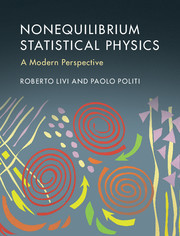Description
Nonequilibrium Statistical Physics
A Modern Perspective
Authors: Livi Roberto, Politi Paolo
A comprehensive and pedagogical text on nonequilibrium statistical physics, covering topics from random walks to pattern formation.
Language: English
Subject for Nonequilibrium Statistical Physics:
Approximative price 85.24 €
In Print (Delivery period: 14 days).
Add to cart
Publication date: 10-2017
434 p. · 19.2x25.3 cm · Hardback
434 p. · 19.2x25.3 cm · Hardback
Description
/li>Contents
/li>Biography
/li>
Statistical mechanics has been proven to be successful at describing physical systems at thermodynamic equilibrium. Since most natural phenomena occur in nonequilibrium conditions, the present challenge is to find suitable physical approaches for such conditions: this book provides a pedagogical pathway that explores various perspectives. The use of clear language, and explanatory figures and diagrams to describe models, simulations and experimental findings makes the book a valuable resource for undergraduate and graduate students, and also for lecturers organizing teaching at varying levels of experience in the field. Written in three parts, it covers basic and traditional concepts of nonequilibrium physics, modern aspects concerning nonequilibrium phase transitions, and application-orientated topics from a modern perspective. A broad range of topics is covered, including Langevin equations, Levy processes, directed percolation, kinetic roughening and pattern formation.
Preface; Acknowledgements; Notations and acronyms; 1. Brownian motion, Langevin and Fokker–Planck equations; 2. Linear response theory and transport phenomena; 3. From equilibrium to out-of-equilibrium phase transitions; 4. Out-of-equilibrium critical phenomena; 5. Stochastic dynamics of surfaces and interfaces; 6. Phase-ordering kinetics; 7. Highlights on pattern formation; Appendix A. Central limit theorem and its limitations; Appendix B. Spectral properties of stochastic matrices; Appendix C. Reversibility and ergodicity in a Markov chain; Appendix D. Diffusion equation and random walk; Appendix E. Kramers–Moyal expansion; Appendix F. Mathematical properties of response functions; Appendix G. The van der Waals equation; Appendix H. The Ising model; Appendix I. Derivation of the Ginzburg–Landau free energy; Appendix J. Kinetic Monte Carlo; Appendix K. Mean-field phase diagram of the bridge model; Appendix L. The deterministic KPZ and the Burgers' equation; Appendix M. The perturbative renormalization group for KPZ: a few details; Appendix N. The Gibbs–Thomson relation; Appendix O. The Allen–Cahn equation; Appendix P. The Rayleigh–Bénard instability; Appendix Q. General conditions for the Turing instability; Appendix R. Steady states of the one-dimensional TDGL equation; Appendix S. Multiscale analysis; Index.
Roberto Livi is Professor of Theoretical Physics at the University of Florence, where he teaches courses on statistical physics and thermodynamics. He is also the Director of the Interdepartment Center for the Study of Complex Dynamics and an associate member of the National Institute of Nuclear Physics (INFN) and of the Institute for Complex Systems of the National Research Council (CNR).
Paolo Politi is Head of the Florence Unit of the Institute for Complex Systems, National Research Council, and teaches statistical physics at the University of Florence. He is Fellow of the Marie Curie Association, of the Alexander von Humboldt Foundation and of the Japan Society for the Promotion of Science. He was awarded the Outreach Prize of the Italian Physical Society for promoting the public discussion of science through Science Cafés.
Paolo Politi is Head of the Florence Unit of the Institute for Complex Systems, National Research Council, and teaches statistical physics at the University of Florence. He is Fellow of the Marie Curie Association, of the Alexander von Humboldt Foundation and of the Japan Society for the Promotion of Science. He was awarded the Outreach Prize of the Italian Physical Society for promoting the public discussion of science through Science Cafés.
© 2024 LAVOISIER S.A.S.

